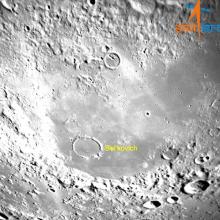Listen to today's episode of StarDate on the web the same day it airs in high-quality streaming audio without any extra ads or announcements. Choose a $8 one-month pass, or listen every day for a year for just $30.
You are here
Moon and Antares
If you watch where the Sun rises and sets every day for a month, there’s generally not a lot of difference. But that’s not the case for the Moon. During its month-long cycle of phases, its rising and setting points race north and south along the horizon.
The Moon stays close to the ecliptic, which is the Sun’s path across the sky. During the year, as the Sun moves north and south, the angle of the ecliptic changes as well. The angle also changes during the day, as Earth rotates on its axis. So where the Moon rises and sets depends on the time of year and the Moon’s angle relative to the Sun, which defines its phase.
So depending on your latitude, the Moon can rise anywhere from roughly southeast to northeast. And although the Moon stays close to the ecliptic, its orbit around Earth is tilted. That allows it to stray about five degrees to either side of the ecliptic. As a result, the Moon’s extreme rising and setting points are five degrees to the north and south of those same points for the Sun.
So like a baby in a cradle, the Moon rocks back and forth along the horizon during its month-long cycle.
Tonight, from the latitudes of the 48 States, the Moon will set a little north of southwest, before midnight. It follows the bright star Antares, the heart of the scorpion, below the horizon. In a couple of weeks, though, the Moon will set a little south of northwest — one-fifth of the way around the sky.
Script by Damond Benningfield






